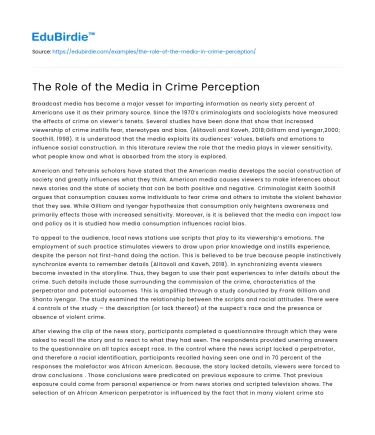Broadcast media has become a major vessel for imparting information as nearly sixty percent of Americans use it as their primary source. Since the 1970’s criminologists and sociologists have measured the effects of crime on viewer’s tenets. Several studies have been done that show that increased viewership of crime instills fear, stereotypes and bias. (Alitavoli and Kaveh, 2018;Gilliam and Iyengar,2000; Soothill, 1998). It is understood that the media exploits its audiences’ values, beliefs and emotions to influence social construction. In this literature review the role that the media plays in viewer sensitivity, what people know and what is absorbed from the story is explored.
American and Tehranis scholars have stated that the American media develops the social construction of society and greatly influences what they think. American media causes viewers to make inferences about news stories and the state of society that can be both positive and negative. Criminologist Keith Soothill argues that consumption causes some individuals to fear crime and others to imitate the violent behavior that they see. While Gilliam and Iyengar hypothesize that consumption only heightens awareness and primarily effects those with increased sensitivity. Moreover, is it is believed that the media can impact law and policy as it is studied how media consumption influences racial bias.
Save your time!
We can take care of your essay
- Proper editing and formatting
- Free revision, title page, and bibliography
- Flexible prices and money-back guarantee
To appeal to the audience, local news stations use scripts that play to its viewership’s emotions. The employment of such practice stimulates viewers to draw upon prior knowledge and instills experience, despite the person not first-hand doing the action. This is believed to be true because people instinctively synchronize events to remember details (Alitavoli and Kaveh, 2018). In synchronizing events viewers become invested in the storyline. Thus, they began to use their past experiences to infer details about the crime. Such details include those surrounding the commission of the crime, characteristics of the perpetrator and potential outcomes. This is amplified through a study conducted by Frank Gilliam and Shanto Iyengar. The study examined the relationship between the scripts and racial attitudes. There were 4 controls of the study — the description (or lack thereof) of the suspect’s race and the presence or absence of violent crime.
After viewing the clip of the news story, participants completed a questionnaire through which they were asked to recall the story and to react to what they had seen. The respondents provided unerring answers to the questionnaire on all topics except race. In the control where the news script lacked a perpetrator, and therefore a racial identification, participants recalled having seen one and in 70 percent of the responses the malefactor was African American. Because, the story lacked details, viewers were forced to draw conclusions . Those conclusions were predicated on previous exposure to crime. That previous exposure could come from personal experience or from news stories and scripted television shows. The selection of an African American perpetrator is influenced by the fact that in many violent crime stories the perpetrator is identified as a Black male. (Gilliam and Iyengar, 2000). This influence is not surprising to academics like Rayeheh Alitavoli and Ehsan Kaveh. They have written that the media employs the tactics of stereotyping and gatekeeping, or filtering information for publication. (Alitavoli and Kaveh, 2018). As the media filters information they are in distorting the image. The misrepresentation of crime encourages viewers to develop stereotypes towards those the media considers violent criminals—African Americans (Soothill, 1998).
The development of racial bias is not the only negative effect of the media’s role in the social construct. ). According to Keith Soothill, the misconception of crime has resulted in an increased sensitivity to it. He writes that people fear the concept of crime and the idea of falling victim to a violent wrongdoing. The Center for Media and Public Affairs provides evidence as to why this might be the case. The Center conducted a study that found that coverage of murder increased by 700% and that overall crime coverage increased by 300%. However, it is worth noting that over the course of the study crime in the United States had decreased from 80% to 20%. This misrepresentation of reality causes individuals to believe that crime is a more prevalent issue thus they fear it more (Alitavoli and Kaveh, 2018).
Hungarian professor, George Gerbner coins this phenomenon “mean world syndrome”. Gerbner used the term “mean world syndrome” to articulate the product of newspapers and local news stations telling their viewers that the world is more dangerous than it actually is. This action of exaggerative gatekeeping increases the likelihood that viewers will develop the syndrome. Increased media consumption coupled with “mean world syndrome” subsequently leads to a fear of crime and a mistrust of the community. Additionally, the increase causes the information to be more prevalent in their mind, which makes it seem like an even grander issue (Soothill, 1998). However, this concept is not accepted by everyone in the field. In their 2000 article, Frank Gilliam and Shanto Iyengar acknowledged that many believe that the media’s portrayal of violent crime increases fear amongst all viewers but argued that fear targets those who are more sensitive. Those sensitivities are decided by uncontrollable factors such as gender, past criminal experiences and their socio-economic status. Gilliam and Iyengar thought this so implicit and uncontrollable that they neglected to account for it in their study.
It is well accepted in the field that the media forms the social construct and subsequently affects what people think and feel. The media has the ability to instill fear and draw upon people’s emotions and sensitivities by exploiting crime stories and stereotypes and employing the process of gatekeeping. The media’s influence on crime perception has been studied for decades and will likely continue to be examined with the expansion of media platforms.






 Stuck on your essay?
Stuck on your essay?

